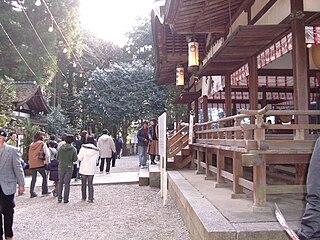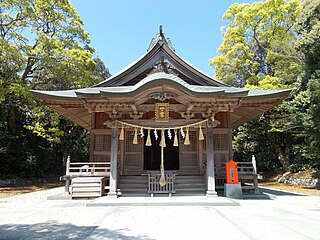
In Japanese religion, Yahata formerly in Shinto and later commonly known as Hachiman is the syncretic divinity of archery and war, incorporating elements from both Shinto and Buddhism.

Empress Jingū was a legendary Japanese empress who ruled as a regent following her husband's death in 200 AD. Both the Kojiki and the Nihon Shoki record events that took place during Jingū's alleged lifetime. Legends say that after seeking revenge on the people who murdered her husband, she then turned her attention to a "promised land". Jingū is thus considered to be a controversial monarch by historians in terms of her alleged invasion of the Korean Peninsula. This was in turn possibly used as justification for imperial expansion during the Meiji period. The records state that Jingū gave birth to a baby boy whom she named Homutawake three years after he was conceived by her late husband.

The Azumi were a warrior clan and tribe during the Jōmon period in Japan, whose cultures and beliefs are considered to be one of Japan's earliest sea religions. Their existence dates back to the early 3rd – 7th centuries, when their extensive knowledge of navigation between waters made them the naval force of Yamato Japan in Kyushu. They lived in Northern Kyushu, especially in an area called Chikuzen, now part of modern-day Fukuoka Prefecture. Their knowledge and ability to use tidal changes, weather patterns and star constellations ensured their successful routing and voyaging on the sea during their regular exploration. In essence, the working of Azumi life was centred around their sea God, Watatsumi and their omnipotent deity ‘Isora’, who provided the Azumi people with a strong sense of spiritual guidance throughout their day-to-day life.

A Shinto shrine is a structure whose main purpose is to house ("enshrine") one or more kami, the deities of the Shinto religion.

Ikuta Shrine is a Shinto shrine in the Chūō Ward of Kobe, Japan, and is possibly among the oldest shrines in the country.
Azumi-no-isora is a shinto kami of the seashore. He is considered to be the ancestor of the Azumi people. He is worshiped at a number of shrines, including Mekari Shrine (和布刈神社) of Kitakyushu, Shikaumi Shrine on Shika Island, and Shiga Shrine (志賀神社) of Tsushima.

Sumiyoshi-taisha (住吉大社), also known as Sumiyoshi Grand Shrine, is a Shinto shrine in Sumiyoshi-ku, Osaka, Osaka Prefecture, Japan. It is the main shrine of all the Sumiyoshi shrines in Japan. However, the oldest shrine that enshrines the Sumiyoshi sanjin, the three Sumiyoshi kami, is the Sumiyoshi Shrine in Hakata.

Ikoma Jinja (生駒神社) is a Shinto shrine in Ikoma, Nara, Japan. Generally called Ikoma Taisha (往馬大社). The formal name of the shrine is "Ikomaniimasu-Ikomatsuhiko Jinja (往馬坐伊古麻都比古神社)". This shrine is also known as "Ikoma-Taisha", which means "great shrine of Ikoma".
Sumiyoshi sanjin (住吉三神) is the generic name for the three Shinto gods Sokotsutsu no O no Mikoto (底筒男命), Nakatsutsu no O no Mikoto (中筒男命), and Uwatsutsu no O no Mikoto (表筒男命). The Sumiyoshi sanjin are regarded as the gods of the sea and sailing. They are sometimes referred to as the Sumiyoshi daijin (住吉大神).

Usa Jingū (宇佐神宮), also known as Usa Hachimangū (宇佐八幡宮), is a Shinto shrine in the city of Usa in Ōita Prefecture in Japan. Emperor Ojin, who was deified as Hachiman-jin, is said to be enshrined in all the sites dedicated to him; and the first and earliest of these was at Usa in the early 8th century. The Usa Jingū has long been the recipient of Imperial patronage; and its prestige is considered second only to that of Ise.

Hakozaki Shrine is a Shintō shrine in Fukuoka.

Kagoshima Shrine is a Shinto shrine located in Kirishima, Kagoshima prefecture, Japan. One of the 2,861 shrines listed in the Engishiki, it is the first shrine in the historic Osumi Province. It is dedicated to Hoori, Toyotama-hime, Emperor Chūai, Emperor Ōjin and Empress Jingū. It is classified as a Beppyo shrine, according to the Association of Shinto Shrines. Historically it was also known by the names "Osumi Sho Hachimangu" and "Kokubu Hachimangu".

Sarutahiko Ōkami is a deity of the Japanese religion of Shinto; he is the leader of the earthly kami. Norito also mentions him with the title Daimyōjin instead of Ōkami. Sarutahiko Ōkami was the head of the kunitsukami and in the Jinnō Shōtōki is said to have been the ancestor of Otanomikoto.

Kagami-jinja (鏡神社) is a Shinto shrine located in Karatsu, Saga prefecture, Japan. The shrine is at the base of Mount Kagami in Genkai Quasi-National Park. It is now called Matsura Sōchinshu Kagami-jinja (松浦総鎮守鏡神社), and formerly known as the name of Kagami no mikoto Byōgū (鏡尊廟宮), Kagami-gū (鏡宮), Matsuura-gū (松浦宮), Itabitsu-sha (板櫃社) and Kuri Daimyōjin (久里大明神).

Ikasuri Shrine is a major Shinto shrine located in central Osaka, Japan. Its annual festival is on April 22. In the former modern system of ranked Shinto shrines it was an imperial shrine of the second rank or kanpei-chūsha (官幣中社). It was also the ichinomiya of the former Settsu Province. It enshrines five kami known as ikasuri no kami or zama no kami: Ikui no kami (生井神), Sakui no kami (福井神), Tsunagai no kami (綱長井神), Hahiki no kami (波比祇神), and Asuha no kami (阿須波神); collectively known as Zamagami (座摩神)
Tsubonuma Hachiman Shrine is a Shinto shrine located in Sendai, Miyagi Prefecture, Japan. It is a Hachiman shrine, dedicated to the kami Hachiman as well as to Emperor Ojin, Empress Jingū, Emperor Chūai, and Takenouchi no Sukune.
Fuyo Jingū was a planned Shintō shrine in Buyeo. It was intended to help with the Japanese occupation of Korea and to be ranked as a Kanpei-taisha. Construction started in 1939 but was never completed. It was highly significant in propaganda with many describing it as the second Shintō capital after Ise Grand Shrine.

Watatsumi Shrine is a Shinto shrine located in Tarumi-ku, Kobe. It is said to have been founded by the legendary Empress Jingu. It is one of the three major shrines of Harima Province. It has a festival on October 11.

Iminomiya Shrine is a Shinto shrine located in Chōfu, Japan. It is a Beppyo shrine, or a shrine that is particularly notable in a certain way with a significant history to it. It is a Ninomiya, or a second rank shrine in its province after the Ichinomiya. In this case the Ninomiya and Soja shrine of the province are combined together. Ichinomiya and Soja shrines were often combined.

Kaijin Shrine (海神神社) also read as Watatsumi Shrine is a significant Shinto shrine located in Tsushima Island, Nagasaki Prefecture, Japan, that holds a Beppyo status. This status denotes that the shrine is remarkable and holds a significant historical importance. Kaijin Shrine is also ranked as an Ichinomiya, which means it is the highest-ranked shrine in its province. It is located near Mount Izu.


















